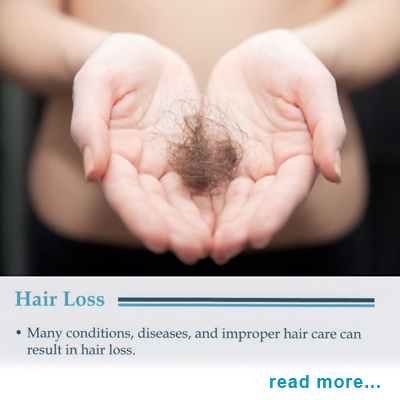Here is the basic hair follicle:
Hair Growth Cycle
First, is anagen,
the growing phase. In anagen,
your hair grows and grows and grows. Then, in catagen it rests. In Telogen, it sheds, and then goes back to anagen. Out of 100,000
to 150,000, it is normal to lose 50 - 100 hairs per day. So,
some hair loss is just part of a natural cycle of hair growth. We normally lose
about 100 hairs a day, but new ones grow back to replace them.
All hair loss is not the same,
and there are many different types of hair
loss
The reasons
for hair loss can vary from genetics and aging to stress and diseases. Hair
loss naturally happens with aging, and is slightly more common in men than
women. In addition to these, hair loss can also happen as a result of a major
surgery, an acute bout of stress, or childbirth. It can also be due to
underlying diseases, such as lupus and diabetes, hormone problems, or the use
of certain medications.
Male pattern
baldness (androgenetic alopecia)
is related to hormones and genetics and is usually a receding hairline with
hair loss at the front near the forehead. androgenetic alopecia affects about 80 per cent of men by age 70.
Dr. Jacobs may want
to discuss Rogaine
solution and/ or Propecia.
Male baldness is better prevented than
treated. Once the hair follicles are dead, they are dead. In many cases, it is
possible to prevent this death. Thus, prevention is especially important for
boys who have a strong genetic link to balding. (Mother’s father is bald) Please
bring them in to see Dr. Jacobs to talk about prevention.
Female pattern
baldness (androgenetic alopecia)
typically consists of thinning hair on top of the scalp. Just as males can lose
hair, so can women.About 40 per cent of women show
signs of androgenetic hair loss by age 50. Genetics are
involved as are hormones, such as lower estrogen levels at menopause. Many women
with hair loss have normal levels of testosterone. Most women with androgenetic alopecia should have their hormones checked.
Dr. Jacobs may want to discuss Rogaine solution and hormonal therapy.
Alopecia areata results in round bald patches (although other patterns are possible) that candevelop anywhere. Alopecia areata is actually an autoimmune disease that often begins in childhood and affects
people of all ages.
Alopecia totalis is
when all scalp hair is lost, resulting in complete baldness.
Alopecia universalis is when all body hair is lost. In
alopecia areata, the affected hair follicles are
mistakenly attacked by a person's own immune system (white blood cells),
resulting in the arrest of the hair growth stage.
Alopecia areata occurs in males and females of all ages and
races, and can be psychologically devastating. Although not life-threatening,
alopecia areata is most certainly life-altering, and
its sudden onset, recurrent episodes, and unpredictable course have a profound
psychological impact on the lives of those disrupted by this disease.
Heredity
sometimes plays a role. In one out of five persons with alopecia areata, someone else in the family has also had it.
Alopecia areata often occurs in families whose
members have had asthma, hay fever, atopic eczema, or other autoimmune
conditions such as thyroid disease, vitiligo,
early-onset diabetes, rheumatoid arthritis, lupus erythematosus, pernicious
anemia, or Addison's disease.
Alopecia areata is often treated with cortisone either topical or
injected, anthralin, and / or Rogain
Trichotillonmania is hair loss caused
by compulsive twisting and twirling of hair, which results in patchy hair breakage.
Hair
loss may seem like a cosmetic issue but it can have negative emotional effects.
Male pattern hair loss, for example, can be associated with low self esteem,
depression and social isolation. Women are more adversely affected by hair loss
than men.
Scarring Alopecia
Scarring alopecia, also known as cicatricial alopecia, refers to hair loss disorders that
may be diagnosed in up to 3% of hair loss patients. Cicatricial alopecia occurs in otherwise healthy men and women of all ages. Here are
features of Scarring Alopecia:
·
Permanent areas of alopecia with loss of visible
follicular openings
·
Destruction of hair follicles and replacement by
fibrous tissue
·
After recovery from the initial injury or
inflammation, there is little hair left.
·
Scarring alopecia can be diagnosed with a simple 3
to 4 mm punch biopsy. Also, a fungal culture and bacterial culture can be
taken.
·
.
While there are many forms of
scarring alopecia, the common theme is a potentially permanent and irreversible
destruction of hair follicles and their replacement with scar tissue.
The biopsy may show one of three
basic types:
Lymphocytic: Scarring alopecias that involve mostly lymphocyte inflammation of
hair follicles, such as lichen planopilaris and pseudopelade, are usually treated with corticosteroid
injections into the skin, topical creams , and/or Pioglitazone
(Actos®) 15mg / day. In addition, antimalarial and isotretinoin medsmay be used.
Neutrophillic: For scarring alopecias with inflammation of mostly neutrophils or a
mixture of cells, the usual treatment involves antibiotics and isotretinoin. Drugs like methotrexate, tacrolimus, cyclosporin, and thalidomide have also been used.
Mixed: May respond to
all of the above. Certainly, cultures
should be taken, and antibiotics should be used.
·
Scarring alopecia almost always
burns out on its own. The bald patches stop expanding and any inflammation,
itching, burning, and pain goes away. In the end, another skin biopsy usually
shows no inflammation around hair follicles. Bald areas usually have no hair
follicles. Sometimes, though, hair follicles, at least those at the periphery
of a bald patch, are not completely destroyed and can regrow, but often all
that is left are just a few scars deep in the skin to show where the hair
follicles once were.
For
hair loss, the patient's history is important:
|
|||
 |
|
|
 |
 |
|||||||||||
 |
|||||||||||||
    
Home | Dry/Sensitive Skin | Skin Renewal | Skin Complexion & Acne | Dermatology Patient Education |













